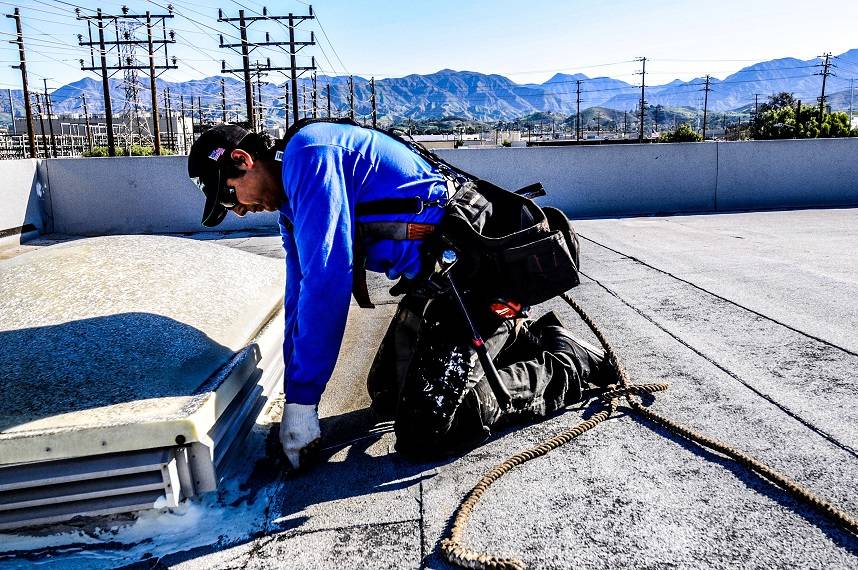At Central Roofing Company, we understand that a sturdy and reliable roof is crucial for the success and safety of your commercial property. Our team of highly skilled and trained roofing professionals is committed to delivering exceptional craftsmanship and superior service in every project we undertake.
3 Surprising Ways So Cal Weather Affects Your Commercial Roof
Commercial Roofs in Southern California don’t get much talked about. In fact with the sunny skies, mild temperatures, and plenty of stuff to do, commercial roofing is probably the last thing on our minds. But the weather here can still have a significant impact on commercial roofing systems. From intense UV radiation to seasonal rains, your roof faces various challenges year-round. Understanding how these conditions affect your roof is key to maintaining its longevity and ensuring your building stays protected. Below are three ways Southern California’s weather impacts commercial roofs and what you can do to minimize potential damage.
1. Prolonged Exposure to UV Rays on your Commercial Roof
One of the most prevalent weather factors in Southern California is constant exposure to the sun. While this region doesn’t see much snow or ice, the relentless UV rays can wear down roofing materials over time. UV radiation causes roofing membranes and coatings to degrade, leading to cracks, splits, and brittleness, especially in materials like asphalt. This is particularly concerning for flat roofs, which are common in commercial buildings, as they have large surface areas exposed to the sun.
How to Protect Your Roof:
Investing in reflective or cool roof coatings can significantly reduce UV damage. These coatings not only protect the roofing material but also help lower the building’s energy consumption by reflecting sunlight and reducing heat absorption.
2. Temperature Fluctuations
While Southern California is known for its warm weather, temperatures can still fluctuate, especially between day and night. The difference between the hot afternoon sun and cooler evenings causes roofing materials to expand and contract. Over time, this thermal cycling can lead to wear and tear on the roof, such as seams pulling apart, cracks in the roofing material, and a weakened overall structure.
How to Protect Your Roof:
To combat temperature-related wear, it’s essential to choose roofing materials designed to withstand expansion and contraction. Thermoplastic materials like TPO and EPDM are highly flexible and perform well in regions with temperature fluctuations. Regular inspections can also help catch early signs of damage caused by thermal cycling.
3. Seasonal Rain and Ponding Water
While Southern California doesn’t experience frequent rainfall, the rain that does occur—especially during the winter months—can pose risks to commercial roofs. Flat or low-sloped roofs are particularly susceptible to water pooling, also known as “ponding water.” If not addressed, ponding water can lead to leaks, weakened roofing structures, and mold growth.
How to Protect Your Roof:
Ensure your roof has proper drainage systems in place, such as well-maintained gutters, downspouts, and drains. Regular roof maintenance before the rainy season will help clear debris and prevent water from collecting on the roof. Additionally, having a professional inspect your roof for any weak spots or potential leaks before the rain hits can save you from costly repairs.
Conclusion
Southern California’s unique weather presents challenges for commercial roofing systems, from UV damage and temperature fluctuations to occasional heavy rains. By taking proactive steps such as applying cool roof coatings, choosing flexible roofing materials, and maintaining proper drainage, you can protect your commercial roof from the effects of the local climate. Regular inspections and preventive maintenance are essential to ensuring your roof remains in excellent condition and can withstand the elements for years to come.
Let’s Fix Your Roof Right — Get a Free Estimate Today
Serving Los Angeles & Orange County for 30+ years.
Trusted. Local. Professional.
Central Roofing Company Headquarters
555 W. 182nd Street
Gardena, CA 90248
📞 310-527-6770

Get A Quote
One of our roofing estimators will gladly meet you to discuss your options and follow up with a free, no-obligation, written estimate.
555 W. 182nd St. Gardena, CA 90248
Ph: 310-527-6770
Our Office Locations:
Our Services
CA license #684960 – Central Roofing, 2025 ©All Rights Reserved | Terms of Use | Privacy Policy | Built by Dymic